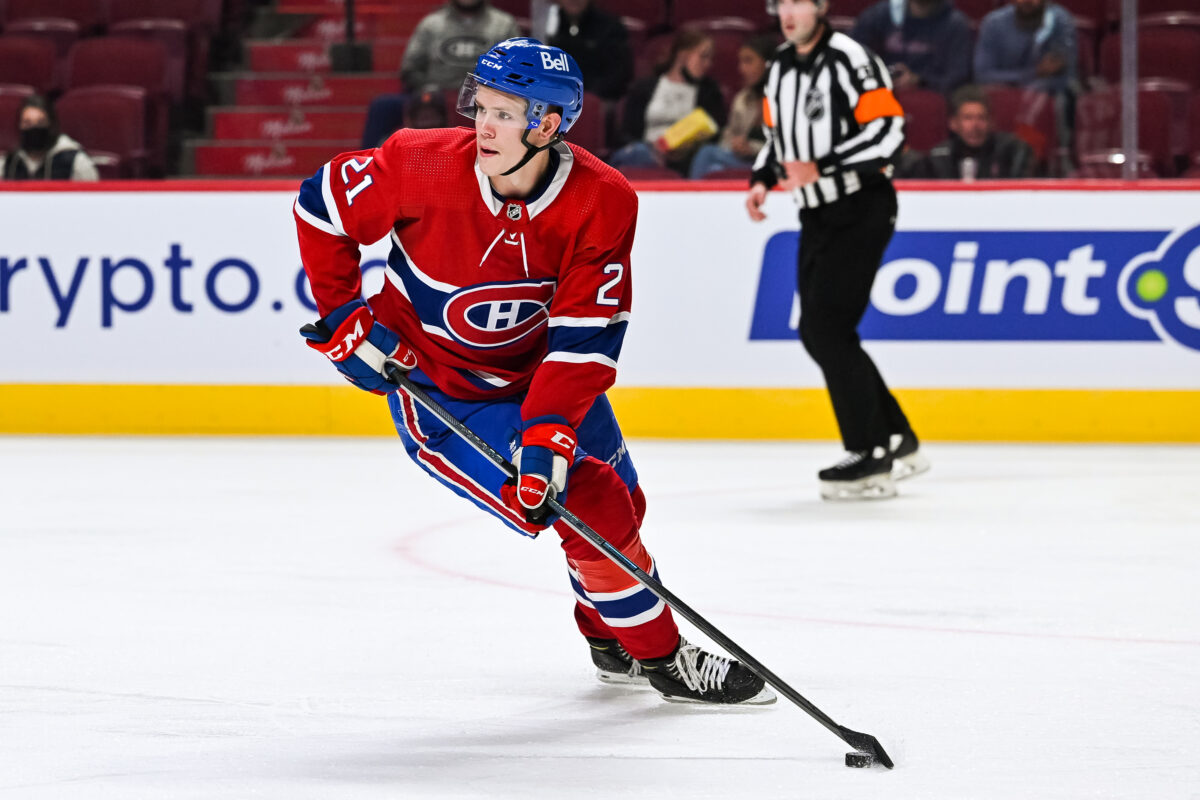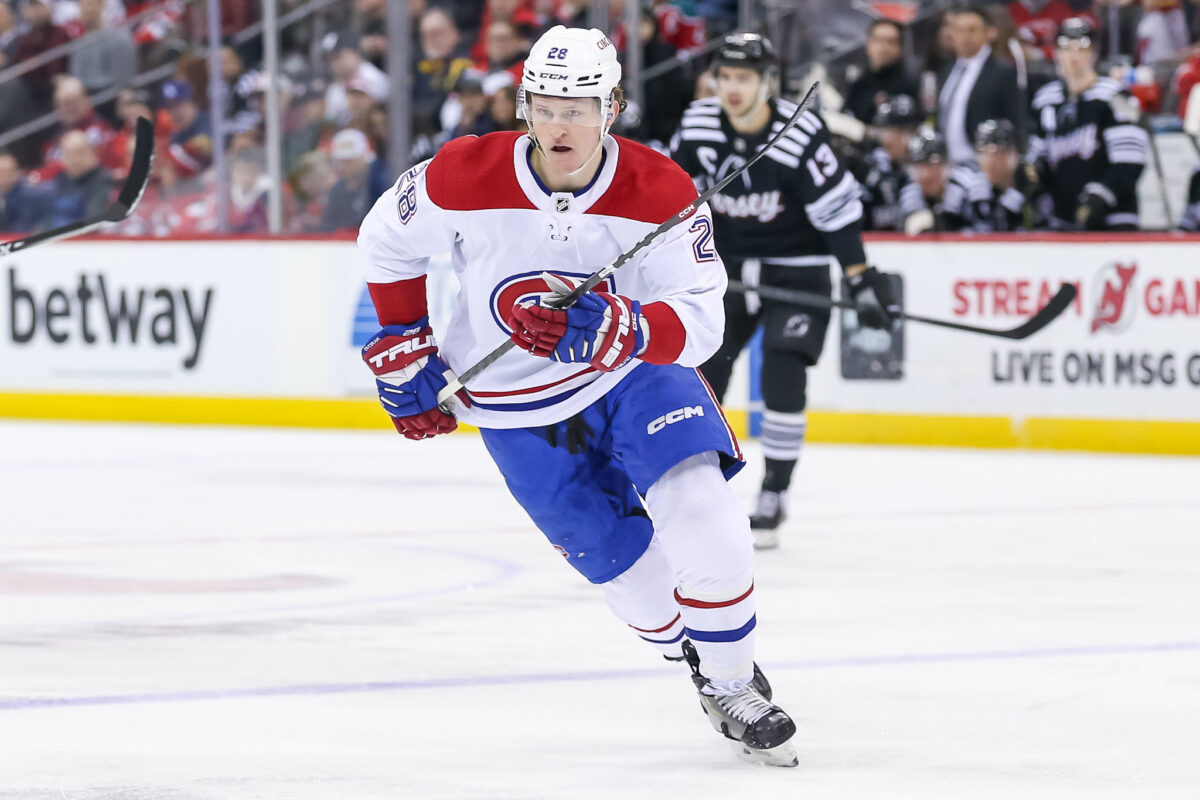The Montreal Canadiens’ 2023 main training camp is now open. Players will weigh in, meet the press, and soon enough, start practices and scrimmages. General manager (GM) Kent Hughes has continued to progress with his rebuild plan.
Related: Canadiens Prospect Pyramid – Summer of 2023
Hughes’ fingerprints are all over the organization, both positive and negative. Since his arrival, his plan for the team has taken shape. With that, here’s a look at the latest 3 Up, 3 Down.
Plus One: More Combative Canadiens
We are seeing improvements in many areas, but one area is combativity. Players are rallying around one another. Last season, we witnessed the emergence of Arber Xhekaj as an intimidating presence on the blue line, and players like Josh Anderson and Kaiden Guhle provided some grit to go along with their size and skill. The Habs are no longer a pushover team; there is some fight in them, which has also spilled into the prospect pool.

During the Rookie Showcase in Buffalo, Logan Mailloux was a wrecking ball. While he is not NHL-ready, his style, to go along with his offensive skills, should give him an opportunity to wear a Canadiens uniform soon.
There are some in the Habs fanbase, who look down on management using the terms character and culture. But a team that has those attributes, and players that are willing to rally around and defend each other, that’s a foundation seen in all the recent Stanley Cup champions. The Habs have more big, fast, and skilled prospects coming up the pipeline. Given the strong work ethic that will be demanded of them, the Canadiens’ rebuild is not only progressing, but it has also begun to harvest one of the main ingredients to establish a winning culture: a collective competitive spirit.
Plus Two: Much More Competition
That competitive fire will also push the players to better themselves and to battle for NHL jobs and even the roles they want to play. Because the team is rebuilding, young players are now making a push for those jobs. Owen Beck and William Trudeau are two who stand out, but the player who was turning heads every shift was Joshua Roy.
After two strong seasons in the Quebec Major Junior Hockey League (QMJHL) and two gold medals at the World Junior Championships (WJC), he was poised to take this step. At 20 years old, he is ready to play professionally. The Rookie Showcase showed that much. Now, he is attending the main camp.
Plus Three: Coaching Systems Evolving
The standard by which head coach Martin St. Louis is being judged is not by wins and losses, for now. Hughes and the rest of the management group have been providing him and the entire team with the leeway to make errors and grow. While St. Louis is an inexperienced NHL head coach, he has a passion for the game and an ability to connect with and teach players.
“I’ve learned the league a little bit in the sense of how teams play and what beats what, where’s the advantage against a certain team’s style. Not every team plays the same way. Not that you’re changing your style based on who you play, but you really talk about where are the holes in the other team’s structure, and I feel that’s a part of the game that I really enjoy. I would say I’ve developed there.”
–Martin St. Louis
What makes him the right person to mentor the Habs’ youth is his ability to communicate. St. Louis played for some well-respected coaches during his Hall-of-Fame career, including Alain Vigneault and Jon Cooper, and he seems to have learned from them and adopted a modern approach to coaching, and perhaps more importantly, a modern approach to the game. While he is learning on the job, his ability to learn, adapt and implement changes will serve him well when the Canadiens start to be judged on wins.
Minus One: Still More Injuries
For the third season in a row, the Habs will start the year with players in the infirmary. Hughes announced that forward Christian Dvorak won’t make his 2023-24 season debut until November, at the earliest. Dvorak last played on March 7 before undergoing season-ending knee surgery and was originally expected to make a full recovery before the start of the season.

The 27-year-old center scored 10 goals and 28 points in 64 games during his second season in Montreal. He also had a faceoff win percentage of 52. Dvorak has two years remaining on his current contract with a cap hit of $4.45 million. Added to the list of injuries is veteran defenseman Chris Wideman. The major issue faced by the Canadiens through this entire rebuild is that no one has been able to see what a healthy Canadiens roster is capable of because it has never been.
Hughes noted that there was no setback in Dvorak’s recovery, only that the organization has made a change in their approach to player recovery. He added that the Canadiens won’t rush anyone’s return “unless we’re 1000% sure”, and that “we don’t want to damage the team’s confidence in seeing a player return then get injured again right away.” If there is a silver lining here, this shows that management has learned from its mistakes and has put into practice what they preached when they made sweeping changes to their Medical Department.
Minus Two: Canadiens are Still Over the Cap
Even though Carey Price will go on LTIR, the team is currently over the cap until he is placed on that list. The fact is, if they can get even to cap, that would maximize the full $10.5 million. Also, the Habs have two salary retention spots already used, leaving only one ahead of a trade deadline that will play a pivotal role in the next stage of the rebuild.
While there is still no pressure to place Carey Price and his $10.5 million cap hit on long-term injured reserve (LTIR) until the opening day of the season, any amount that Hughes allows the team to be over the cap at the start of the season before he makes this move, will impact the total he would have available to him this season. By placing a player on LTIR after the season begins, he will then begin to accrue cap space – meaning, if a player is placed on LTIR and the team sits exactly at the $83.5 million cap ceiling, that team could take advantage of the entire cap hit of that player. Any overages cut the value of the cap space made available by the LTIR for Price, for example, if they were $1 million over, it would mean that the Habs could only have $9.5 million available from Price being on LTIR.
Minus Three: Lack of Elite Talent in System
The Canadiens’ prospect pool has become vastly improved in just a few short years. However, despite its depth and all the great young players reaching the NHL, there is no elite talent. Yes, Caufield is a possible 50-goal talent (which is elite), but he lacks a complete game. The strength of the system lies in its impressive defensive depth (and there may yet be a game-breaker in there with David Reinbacher), and there is even some potential first-line talent but no surefire elite all-star franchise player.
That said, there are signs that Hughes is preparing to trade for one if he is unable to draft that elusive elite all-around franchise player. Looking ahead to 2025, the Canadiens now hold two picks in each of the first, second, third and fourth rounds, added to those, the expected salary cap space available to Montreal, and the sheer depth of young defenders, and he has the basis to make a significant move.
The 2023 Training Camp is set to be one of the more entertaining ones in the last few seasons. While there have been some problems, instead of being insurmountable as they were just three years ago, now they can be solved. There is no direct path from cellar-dweller to Stanley Cup contender, but at least Hughes is taking the Habs on an upward path.
